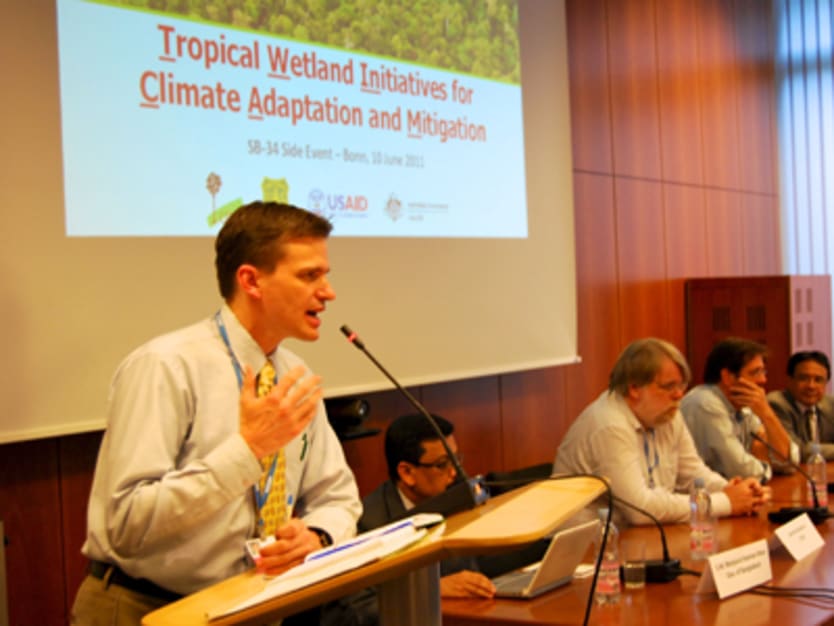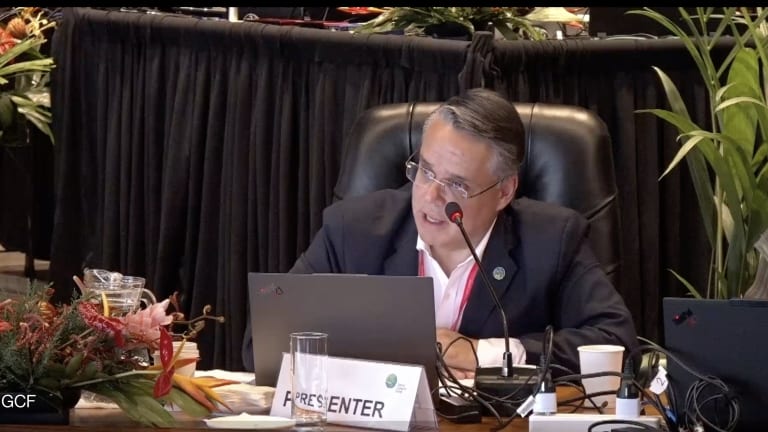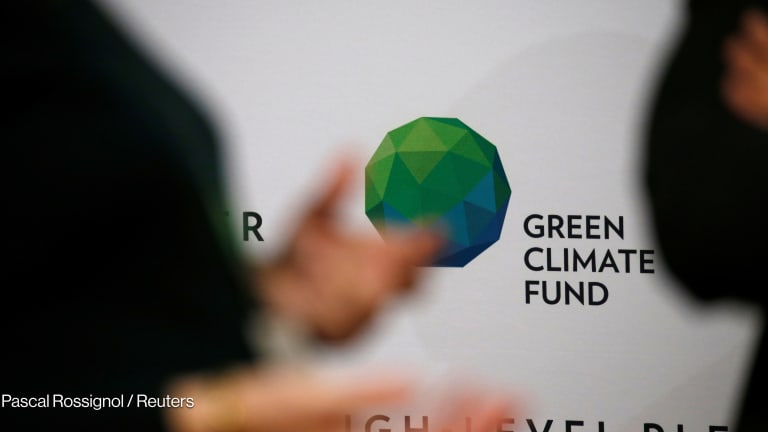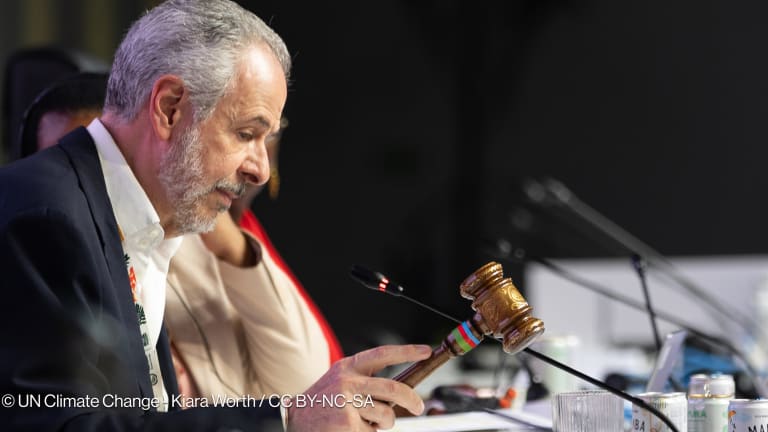
If this year’s first Green Climate Fund meeting is anything to go by, then GCF’s future is still uncertain, as there remain several undefined areas that the fund has yet to address.
Held Feb. 19 to 21 in Bali, Indonesia, the meeting garnered pledges from two countries: 500,000 euros ($687,000) from Italy and $250,000 from Indonesia. While welcome — Indonesia’s commitment is particularly appreciated since developing countries are under no obligation to contribute to the GCF — these are paltry sums compared with the $10 billion participants hoped donors would pledge at the meeting.
The recent Bali meeting also triggered doubts about whether the annual target of $100 billion in climate financing until 2020 — the amount that the 2009 U.N. Climate Summit in Copenhagen decided was necessary to ease the impact of climate change on developing countries — will remain a pipe dream.
The noncommittal GCF meeting held in Paris, France, last year left participants and observers wanting as it failed to decide on matters that are crucial to the operation of the fund and garner pledges from developed countries such as the United States, Japan and United Kingdom.
The Bali meeting raised the same fears. Investments in combating climate change, after all, have remained lukewarm. A report by the Overseas Development Institute, in collaboration with the Heinrich Böll Foundation, noted a 71 percent drop in multilateral climate financing pledges in 2013.
“We’ve seen a sharp decline in commitments coming through multilateral funds. We need to get the GCF to move from a good idea in theory to a game-changer in practice,” Smita Nakhooda, lead climate finance analyst, said in the report.
More importantly, the Bali meeting again stirred anxieties about whether the GCF will even take off. According to Brandon Wu, senior policy analyst at ActionAid USA, several decisions have been pushed aside at the Bali meeting.
Wu noted that there were eight key areas that had to be decided on before the GCF could receive contributions from donor countries. These involved decisions on the following:
The initial fund and secretariat structure.
The fund’s financial risk management and investment frameworks.
Initial results areas.
Procedures for accrediting national, regional and international implementing entities and intermediaries.
Policies and procedures for the initial allocation of fund resources.
The initial proposal approval process.
The initial modalities and the Private Sector Facility.
The terms of reference of the fund’s Independent Evaluation Unit, the Independent Integrity Unit and the independent redress mechanism.
Two key decisions
Before the meeting, Michele de Nevers, a senior associate at the Center for Global Development, told Devex that GCF should adopt what U.S. President Barack Obama called in his 2012 State of the Union address the “all-of-the-above” approach to mitigation and adaptation.
The manner of allocation, which aims for a 50:50 balance between mitigation and adaptation activities, is one of the two key decisions made at the Bali meeting.
Mitigation, which involves reducing future emissions, has generally been a more attractive approach to the private sector. On the other hand, adaptation entails curbing climate change impacts that are already happening — and requires a stronger commitment.
In 2012, Kiribati, a low-lying island nation in the Pacific, hit the headlines for mulling a move to Fiji’s Vanua Levu island because of the threat of rising sea levels. The drastic plan, which would entail relocating the nation’s more than 100,000 islanders, signaled a growing climate change challenge that urgently needs to be addressed.
The allocation decision made at the Bali meeting, which also guarantees that 50 percent of adaptation funding, or a quarter of the GCF’s total resources, would be channeled toward vulnerable areas like Kiribati, along with other small island developing states, the African states and the least developed countries, is therefore a welcome development.
“While the language [of the decision] is weak, this is a step in the right direction, given that the vast majority of climate finance to date has been for mitigation and biased toward middle-income countries,” Wu told Devex.
The other decision, however, leaves much to be desired. Participants sought to clarify eligibility requirements in the independent redress mechanism, which was designed to respond to complaints arising from GCF-funded activities. But the result turned out to be a restrictively worded decision where only people “directly affected” by GCF activities would be able to use the mechanism. This may have the unfortunate effect of alienating those who cannot otherwise prove the impact of GCF activities on their communities.
“Given this weak redress mechanism, it is even more imperative that the GCF ensure its multistakeholder consultation processes and environmental and social safeguards are extremely robust,” Wu said.
Unresolved issues
There was also some uproar among nongovernmental organizations over the role of the private sector in funding the GCF. While support from private companies is indispensable, there remains some skepticism about the influence the sector will play in funding projects.
For instance, developed countries’ private sector investments in climate projects tend to be self-contained. There is a preference for low-risk environments among investors, according to the Climate Policy Initiative’s “The Global Landscape of Climate Finance 2013 Report.”
Money flowing between developed countries largely comes from the private sector, while much of the money flowing from developed countries to developing ones is from the public sector.
“International climate finance, including the GCF, needs to be flexible and adaptable to catalyze, complement, and support domestic sources of finance,” de Nevers said. “The GCF cannot be the tail wagging the dog.”
Other important issues — such as how funding will be determined and decided — do not fall neatly into the eight key areas that the GCF board sought to address. At the core of these concerns is country ownership, which remains an unresolved issue. Wu believes that a comprehensive understanding of country ownership — an area that concerns decisions on the no-objection procedure and the role of Nationally Designated Authorities — is crucial to GCF’s vision.
A decision on the no-objection procedure, which will enable a host country to decide on whether a project is consistent with its development priorities, was stalled at the Paris meeting. If a decision is made on this procedure at the next GCF meeting — which will be held in Songdo, South Korea, from May 18 to 21 — then it will be a step toward the much-touted multistakeholder engagement that NGOs are advocating.
The role of the NDAs, meanwhile, remains unclear in the overall structure of the GCF. A well-defined role for NDAs, however, will fit with the GCF ideal of country ownership and ensure that developing countries have a stake in the priorities and projects within its borders.
“We want to see the GCF use a country-driven approach that goes beyond government ownership and encompasses ownership of the full range of domestic stakeholders, especially affected communities. Decision-making around GCF activities should be driven by robust multistakeholder consultation processes, at all levels (project, program and strategic) and throughout the funding cycle,” Wu said. “While previous board decisions and the GCF Governing Instrument pay lip service to multistakeholder engagement, the way in which this will be operationalized, and whether or not it will be a mandatory part of all funding cycles, is yet to be decided.”
The GCF, de Nevers believes, can also be most effective “by building on existing national and international structures.”
Join the Devex community and gain access to more in-depth analysis, breaking news and business advice — and a host of other services — on international development, humanitarian aid and global health.








